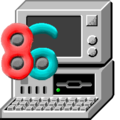Hardware
The main goal of 86Box is to emulate various IBM PC compatible systems/motherboards from 1981 until 1999, which includes almost all IBM PC models (including the IBM PS/1 model 2121 and the IBM PS/2 model 2011) and supports IBM PC compatible systems/motherboards.
86Box is capable of emulating Intel processors (and its respective clones, including Advanced Micro Devices, IDT and Cyrix) from Intel 8088 through the Pentium Tillamook MMX/Mobile MMX processors and Pentium Pro/Pentium II processors from 1997 until 1999. [1] A recompiler is mandatory for P5 Pentium and Cyrix processors and optional for i486 processors and IDT WinChip processors.
86Box can emulate different graphic modes, this includes text mode, Hercules, CGA (including some composite modes and the 160 × 100 × 16 tweaked modes), Tandy, EGA, VGA (including Mode X and other tweaks), VESA, as well as various video APIs such as DirectX and 3Dfx's Glide. 86Box can also emulate various video cards such as the ATI Mach64 GX and the S3 Trio32/64/Virge series. Voodoo cards are also emulated with support for Voodoo 1/2/3 and various optimizations. A separate recompiler has been added for Voodoo emulation, making it faster to emulate the Voodoo graphics card.
86Box can emulate some sound cards, such as the AdLib, Sound Blaster (including the Game Blaster), Sound Blaster Pro, Sound Blaster 16, Sound Blaster AWE32, Gravis UltraSound, Innovation SSI-2001, Aztech Sound Galaxy Pro 16, Windows Sound System, Ensoniq AudioPCI 64V/ES1371, and Sound Blaster PCI 128.
86Box also emulates some SCSI cards, such as SCSI cards from BusLogic and Symbios Logic.
Operating system support
Similar to Virtual PC, Bochs and QEMU, 86Box supports almost all versions of Microsoft Windows until Windows 7 (including Service Pack 1); MS-DOS, FreeDOS and CP/M-86 are also supported. Earlier versions of OS/2 requires the hard drive to be formatted prior to installation, while OS/2 Warp 3 until Warp 4.5 requires an unaccelerated video card to run. Other operating systems are also supported on 86Box, such as versions of Linux that support the Pentium processor, BSD derivatives (e.g. FreeBSD), and BeOS 5, which only works on the Award SiS 497 motherboard.


